Configure
The Configure section of the Pomerium Enterprise Console houses settings that affect the entirety of the Console environment, i.e. across all Namespaces. Adjust these settings with care.
Settings
The Settings section holds global settings that affect how the Pomerium Enterprise Console runs, logs, and communicates. Values set here are applied globally, except for settings documented to override global options.
Some options may be unset by default. These settings use the values set in Pomerium Core, unless overridden in the console.
Global
Debug
danger
Enabling the debug flag could result in sensitive information being logged!!!
By default, JSON encoded logs are produced. Debug enables colored, human-readable logs to be streamed to standard out. In production, it is recommended to be set to false.
For example, if true
10:37AM INF cmd/pomerium version=v0.0.1-dirty+ede4124
10:37AM INF proxy: new route from=verify.localhost.pomerium.io to=https://verify.pomerium.com
10:37AM INF proxy: new route from=ssl.localhost.pomerium.io to=http://neverssl.com
10:37AM INF proxy/authenticator: grpc connection OverrideCertificateName= addr=auth.localhost.pomerium.io:443
If false
{"level":"info","version":"v0.0.1-dirty+ede4124","time":"2019-02-18T10:41:03-08:00","message":"cmd/pomerium"}
{"level":"info","from":"verify.localhost.pomerium.io","to":"https://verify.pomerium.com","time":"2019-02-18T10:41:03-08:00","message":"proxy: new route"}
{"level":"info","from":"ssl.localhost.pomerium.io","to":"http://neverssl.com","time":"2019-02-18T10:41:03-08:00","message":"proxy: new route"}
{"level":"info","OverrideCertificateName":"","addr":"auth.localhost.pomerium.io:443","time":"2019-02-18T10:41:03-08:00","message":"proxy/authenticator: grpc connection"}
HTTP Redirect Address
If set, the HTTP Redirect Address specifies the host and port to redirect http to https traffic on. If unset, no redirect server is started.
DNS Lookup Family
The DNS IP address resolution policy. If not specified, the value defaults to AUTO.
Log Level
Log level sets the global logging level for pomerium. Only logs of the desired level and above will be logged.
Proxy Log Level
Proxy log level sets the logging level for the Pomerium Proxy service access logs. Only logs of the desired level and above will be logged.
Cookies
HTTPS Only
If true, instructs browsers to only send user session cookies over HTTPS.
warning
Setting this to false may result in session cookies being sent in cleartext.
Javascript Security
If true, prevents javascript in browsers from reading user session cookies.
warning
Setting this to false enables hostile javascript to steal session cookies and impersonate users.
Expires
Sets the lifetime of session cookies. After this interval, users must reauthenticate.
Timeouts
Timeouts set the global server timeouts. Timeouts can also be set for individual routes.
GRPC
GRPC Server Max Connection Age
Set max connection age for GRPC servers. After this interval, servers ask clients to reconnect and perform any rediscovery for new/updated endpoints from DNS.
See https://godoc.org/google.golang.org/grpc/keepalive#ServerParameters (opens new window) for details
GRPC Server Max Connection Age Grace
Additive period with grpc_server_max_connection_age, after which servers will force connections to close.
See https://godoc.org/google.golang.org/grpc/keepalive#ServerParameters (opens new window) for details
Tracing
Tracing tracks the progression of a single user request as it is handled by Pomerium.
Each unit of work is called a Span in a trace. Spans include metadata about the work, including the time spent in the step (latency), status, time events, attributes, links. You can use tracing to debug errors and latency issues in your applications, including in downstream connections.
Tracing Sample Rate
Percentage of requests to sample. Default is .01%.
Unlike the decimal value notion used for the tracing_sample_rate key in open-source Pomerium, this value is a percentage, e.g. a value of 1 equates to 1%
Authenticate
Proxy
Certificate Authority
This defines a set of root certificate authorities that Pomerium uses when communicating with other TLS-protected services.
Note: Unlike route-specific certificate authority settings, this setting augments (rather than replaces) the system's trust store. But routes that specify a CA will ignore those provided here.
warning
Be sure to include the intermediary certificate.
Default Upstream Timeout
Default Upstream Timeout is the default timeout applied to a proxied route when no timeout key is specified by the policy.
JWT Claim Headers
The JWT Claim Headers setting allows you to pass specific user session data to upstream applications as HTTP request headers. Note, unlike the header x-pomerium-jwt-assertion these values are not signed by the authorization service.
Additionally, this will add the claim to the X-Pomerium-Jwt-Assertion header provided by pass_identity_headers, if not already present.
Any claim in the pomerium session JWT can be placed into a corresponding header and the JWT payload for upstream consumption. This claim information is sourced from your Identity Provider (IdP) and Pomerium's own session metadata. The header will have the following format:
X-Pomerium-Claim-{Name} where {Name} is the name of the claim requested. Underscores will be replaced with dashes; e.g. X-Pomerium-Claim-Given-Name.
This option also supports a nested object to customize the header name. For example:
jwt_claims_headers:
X-Email: email
Will add an X-Email header with a value of the email claim.
Use this option if you previously relied on x-pomerium-authenticated-user-{email|user-id|groups}.
X-Forward-For HTTP Header
Do not append proxy IP address to x-forwarded-for HTTP header. See Envoy docs for more detail.
Response Headers
Set Response Headers allows you to set static values for the given response headers. These headers will take precedence over the global set_response_headers.
Service Accounts
Service accounts offer a protected and standardized method of authenticating machine-to-machine communication between services protected by Pomerium.
tip
Before you begin, confirm you are in the correct Namespace. A service account can only be used in the Namespace it was created in, including its children Namespaces.
From the main menu, select Service Accounts under CONFIGURE. Click the + ADD SERVICE ACCOUNT button:
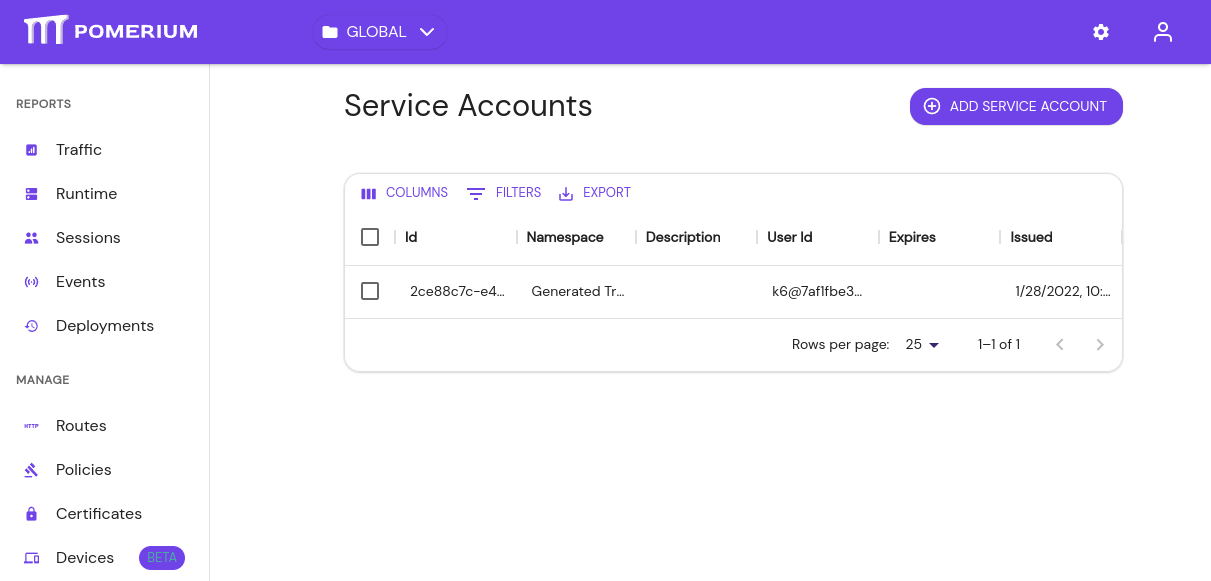
Service accounts can be unique and exist only for Pomerium, or impersonate directory users from your IdP.
Give the user a unique ID, or select an existing user to impersonate. Consider referencing the Namespace you're creating it under, for easier reference later. Optionally set an expiration date:
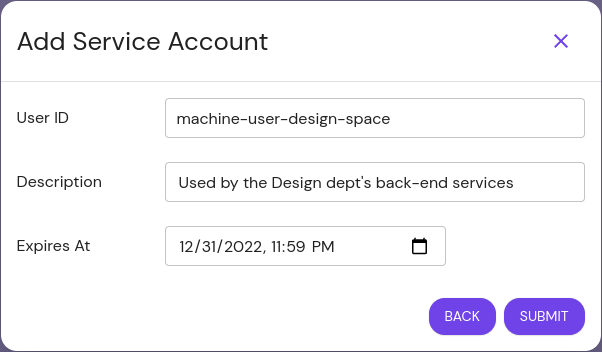
The user ID set here corresponds to the
Usercriteria when editing a policy.After you click Submit, the modal presents the JSON web token (JWT) for the service account. Temporarily save it somewhere secure, as you will not be able to view it again:
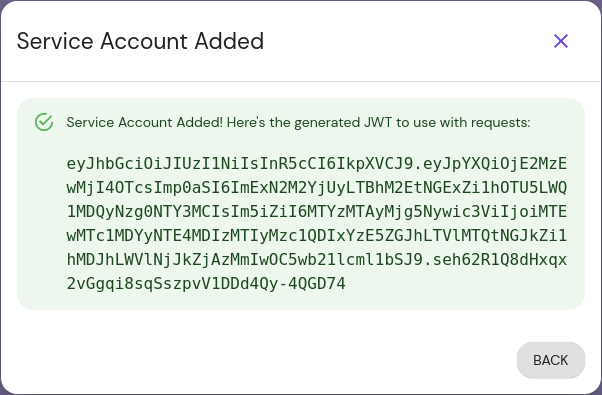
This JWT must be added to your application configuration to enable direct communication.
Edit or create policies to give the service account access to the internal service:
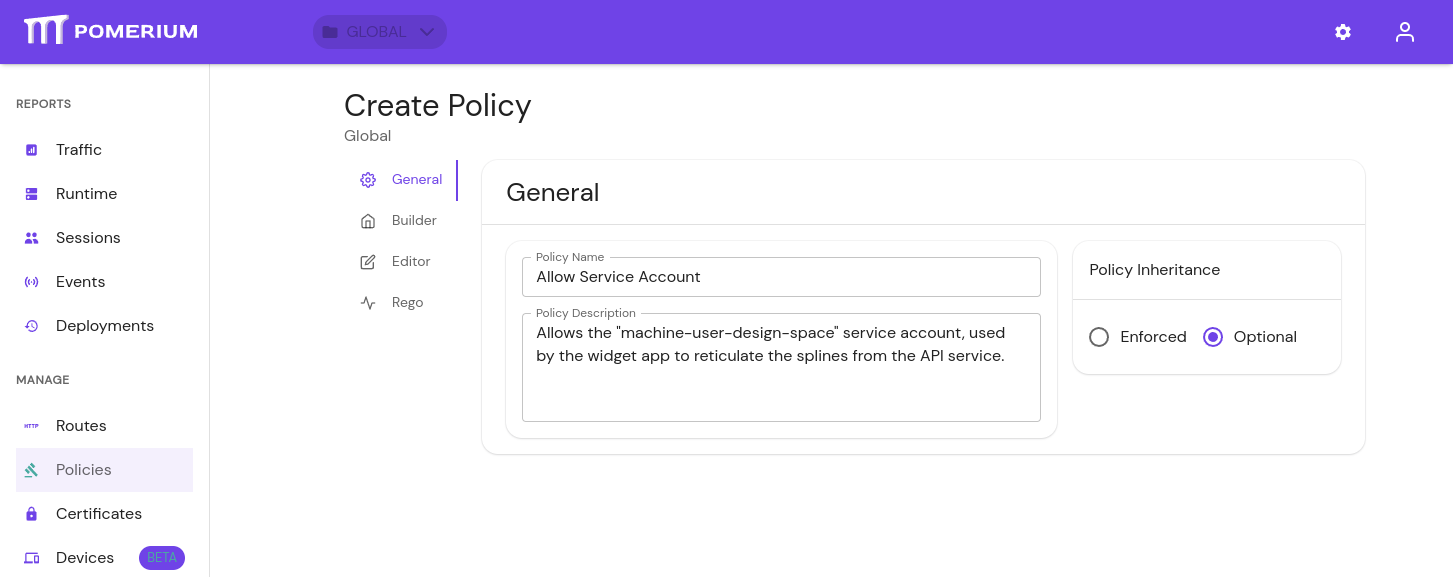
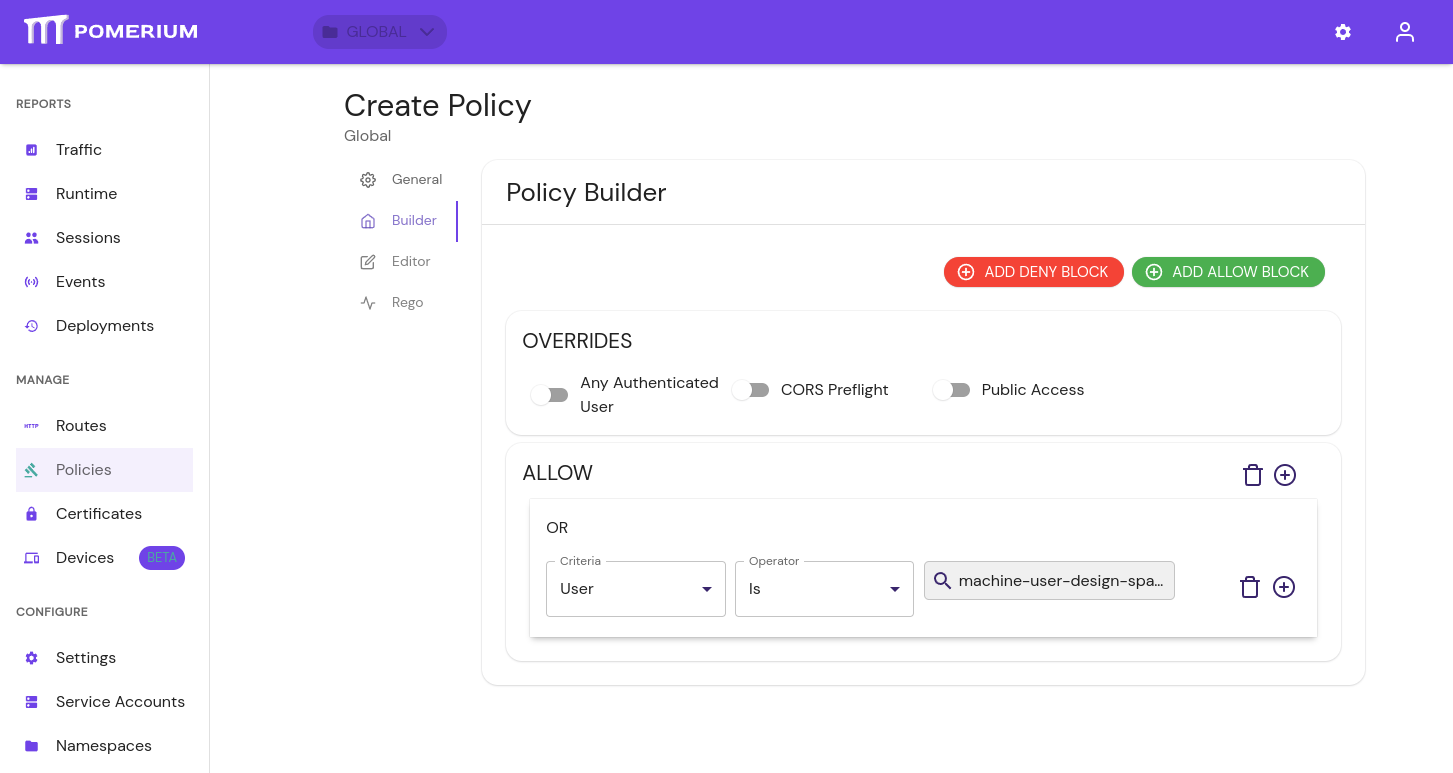
Namespaces
A Namespace is a collection of users, groups, routes, and policies that allows system administrators to organize, manage, and delegate permissions across their infrastructure.
- Policies can be optional or enforced on a Namespace.
- Enforced policies are also enforced on child Namespaces, and optional policies are available to them as well.
- Users or groups can be granted permission to edit access to routes within a Namespace, allowing them self-serve access to the routes critical to their work.
tip
When using an IdP without directory sync or when working with non-domain users, they will not show up in the look-ahead search. See Non-Domain Users for more information.
External Data
This section lets administrators add and manage external data sources. Information from external data sources can be used to extend policies.
Add or Edit External Data Source
URL
The path to the external data. The supported formats are:
JSON file containing an array of objects. each object must contain an
idfield.example JSON[
{ "id": "id4@example.com", "user.id": "user4" },
{ "id": "id5@example.com", "user.id": "user5" },
{ "id": "id6@example.com", "user.id": "user6" }
]CSV file, where the first row indicates the field names and subsequent rows are records. One of the fields must be an
id.example CSVid,user.id
id1@example.com,user1
id2@example.com,user2
id3@example.com,user3A tar or zip file containing files of one of the formats above. The file path within the tar file specifies the record type, if not defined in the configuration. For example, in an archive containing the following structure:
example.com/geoip.csv
devices/jamf.json
devices/tanium.jsonThe Pomerium Databroker would be updated with types
example.com/geoip,devices/jamf, anddevices/tanium.- Compressed versions are supported using
gzformat.
- Compressed versions are supported using
Record Type
Unless defined by the directory structure of a supplied archive file, the Record Type field defines how the records will be stored and accessed in the Databroker.
Foreign Key
This value is used to map an authorization evaluation to the corresponding record. The supported values are:
user.id(Also the default if no value is provided),user.email,request.ip,device.id.
Headers
Headers defined here will be used when connecting to the external data source.
Allow Insecure TLS
If set, allows the import of external data from sources using untrusted TLS certificates.
Polling Min/Max Delay
Defines the minimum and maximum delay times between requests to the external data source.
Client TLS Key
For data sources using mTLS, you can select a client certificate (added under Manage → Certificates) to provide to the data source.
See External Data Sources for more information on this feature.